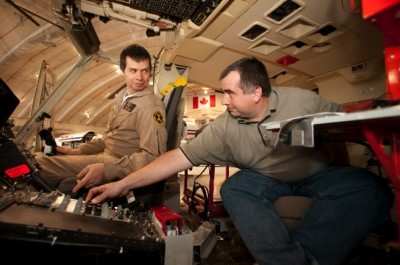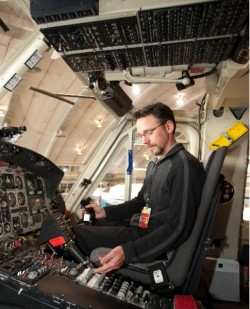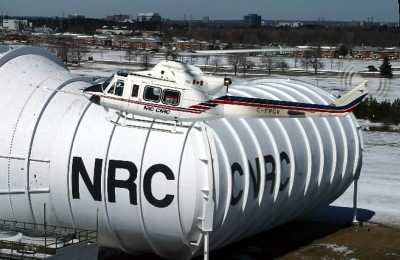National Research Council-Designed System Primarily For
Fly-By-Wire Rotary-Wing Aircraft
Ottawa-based National Canada Institute for Aerospace
Research (NRC Aerospace) has developed what it says is a unique and
revolutionary technology for fly-by-wire aircraft, which will allow
pilots to operate complex aircraft with a single pilot command
interface acting as an independent controller of multiple input
modes, simultaneously.

(L-R) NRC Test Pilot Stephan Carignan, System Designer Bill
Gubbels
NRC Aerospace says this is a major
breakthrough in the development of advanced aircraft control
systems, allowing pilots to operate their aircraft to its maximum
capabilities, more safely. NRC's technique blends rotorcraft
control response types so that the frequency of the pilot's input
determines the control response type applied. With this approach, a
pilot making slow/deliberate inputs, for example, those typically
used in poor visual conditions, commands the aircraft via
Translational Rate Control (TRC). Whereas a pilot using rapid
control inputs, of the type more common in well-cued environments,
channels the control input to attitude and rate command control
systems. This control structure allows for the stability of a TRC
system to be coupled with the performance of a rate command system
without requiring discrete mode switching by the pilot.
"Our researchers, Bill Gubbels and Kris Ellis, developed this
technology over the last four years, and the results are truly
revolutionary for pilots flying rotary-wing, fly-by-wire aircraft,"
said NRC Aerospace Flight Research Laboratory (FRL) director,
Stewart Baillie. "This new control system architecture gives
pilots stability when they need it and agility when they request
it; all without making deliberate "mode-choice" decisions on what
the situation demands. I had the opportunity to fly this system in
our technology demonstrator Bell 412 helicopter, and now I wouldn't
want to fly any other way," he added.
In its development, the interface was tested at NRC Aerospace's
FRL in Ottawa, using its Bell 412 as a test platform. This new
technology works by simplifying the aircraft control system so that
in critical moments pilots can focus on flying rather than trying
to manage a difficult control system with multiple discrete
modes.

NRC System Developer Kris Ellis
Rotorcraft require both the ability to maneuver aggressively and
provide a stable platform. Pilots switch from quick
aggressive inputs to slow deliberate inputs depending primarily on
their ability to gain information through their visual external
cueing. When there is a degraded visual environment such as
"brownout" in sandy conditions, or 'whiteout' in the case of snow,
higher levels of stability augmentation are desirable. These
higher levels reduce the pilot's workload by automatically
balancing and counterbalancing the controls that stabilize the
aircraft, but it also reduces the pilot's ability to aggressively
maneuver the aircraft. When visual cues are good, pilots can select
lower levels of stability augmentation so that they can be more
aggressive and precise in their handling.
NRC Aerospace's new control system architecture consolidates
both of these augmentation systems into one integrated system so
that pilots no longer need to manually select to transition between
these different response modes. In difficult situations these
transitions can be distracting and take a pilot's attention away
from other important tasks. Significantly delayed transitions can
result in damaged aircraft. For aircraft that operate in bad
weather conditions or in combat operations, this technology could
prove extremely useful. The single response mode provides both the
stability of high augmentation responses, and the maneuverability
of minimal stability augmentation, where possible.

"This product is now available to potential licensees, and we
believe it's something that every new and retrofit fly-by-wire
aircraft should have installed," said designer Bill Grubbels. "The
potential for this control architecture to improve operational
effectiveness, particularly for military applications, is
exponential."
NRC Aerospace is currently seeking application partners;
potential users can contact the department for more information and
to access the NRC's staff who can explain further the interface's
applications.
 ANN FAQ: Submit a News Story!
ANN FAQ: Submit a News Story! Aero-News: Quote of the Day (06.12.24)
Aero-News: Quote of the Day (06.12.24) ANN's Daily Aero-Linx (06.12.24)
ANN's Daily Aero-Linx (06.12.24) ANN's Daily Aero-Term (06.12.24): Adcock Range
ANN's Daily Aero-Term (06.12.24): Adcock Range Airborne Affordable Flyers 06.06.24: 200th ALTO, Rotax SB, Risen 916iSV
Airborne Affordable Flyers 06.06.24: 200th ALTO, Rotax SB, Risen 916iSV





